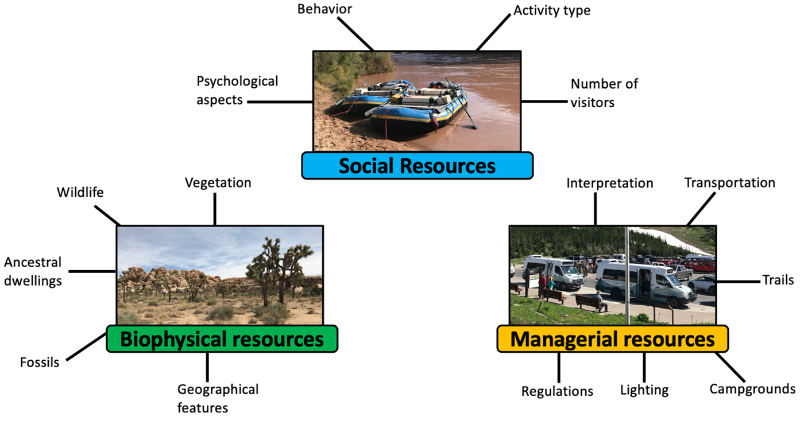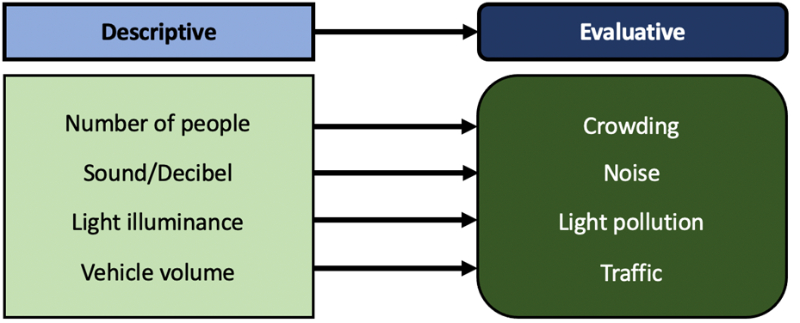What is visitor use management? Identifying functional and normative postulates of an interdisciplinary field of study
Science & Research
April 2022 | Volume 28, Number 1
In 1864, US President Abraham Lincoln unknowingly set off an international movement when he granted Yosemite Valley to the State of California for “the express conditions that the premises should be held public use, resort, and recreation” (Yosemite Grant Act of 1864). Yellowstone National Park (Wyoming/Montana/Idaho) further underscored this idea by becoming the world’s first national park, which was designated as “a pleasuring-ground for the benefit and enjoyment of the people” in 1872 (Yellowstone Park Act of 1872). By 1916 more than a dozen areas in the United States were designated as national parks and housed under the National Park Service (NPS). The enabling legislation for the NPS (Organic Act of 1916) solidified parks as places for visitor use and enjoyment. However, national parks were responsible more for just human enjoyment, and a dual mandate of providing for visitor use and experience in a way that conserves resources unimpaired became the defining challenge for parks and other protected areas into the future (Organic Act of 1916).
Not long after the national park idea took root, people wondered “how large a crowd can be turned loose in a wilderness without destroying its essential qualities?” (Sumner 1936). The response to this question was delayed, but the post-World War 2 boom of visitation to parks and protected areas reignited interest in actively managing visitor use. Early inquiry into visitor use management started with the idea of carrying capacity (Wagar 1964), but the concept was and continues to be challenging in application to visitor use (Allen 2019; McCool & Lime 2001; McCool et al. 2014; Miller et al. 2019; Whittaker et al. 2011). Fundamentally, there is no one carrying capacity, and any assessments of capacity must consider human values in the process and evaluation of resource impacts from visitor use (Wagar 1964).
Rising to the challenges presented in early carrying capacity inquiries, numerous frameworks integrating the human value aspects of visitor use management emerged. These frameworks are generally termed Management-By-Objectives frameworks (MBOs) and include Limits of Acceptable Change (McCool, Clarky, & Stankey 2007; Stankey, McCool, & Stokes 1984; Stankey et al. 1985), Visitor Impact Management (Graefe, Kuss, & Vaske 1990), Visitor Experience and Resource Protection (Hof & Lime 1997), and the recent Interagency Visitor Use Management Framework (IVUMF 2016). Collectively, these frameworks attempt to answer a perennial question: How much and what types of visitor use and/or resource change can be accommodated in an area before the very conditions people are seeking are unacceptably degraded? (Miller et al., 2019). Attempts to answer this question today are what is generally called visitor use management.
For over fifty years, scientists, researchers, and other professionals have attempted to improve visitor experiences and protect biophysical resources through a field of inquiry called visitor use management. Although often thought of as a framework or a process, visitor use management can also be described as a field of study with its own set of unique axioms. In this article, normative and functional postulates are developed to define these visitor use management axioms. From this, the context from which visitor use management is approached is clearly defined and sets a stage for identifying emerging priorities and needs in a time of critical change.
Axioms of visitor use management
Visitor use management is thought of as a framework or a process. However, in this article it is proposed that visitor use management is also an interdisciplinary field of inquiry. Although emergent of and related to numerous other fields of inquiry including conservation social science, tourism management, and other “human dimensions” fields (see Bennett et al. 2017), a unique set of axioms emerge from visitor use management inquiry. Like other interdisciplinary fields of inquiry, these axioms are identified through functional and normative postulates (Kareiva & Marvier 2012; Soulé, 1985). Functional postulates are core principles associated with a field of inquiry, and normative postulates are core values associated with a field of inquiry. This article identifies, describes, and provides evidence of the axioms from past work in the interdisciplinary field of visitor use management. Like other fields of inquiry, these axioms shape the context in which inquiry into visitor use management occurs.
Functional postulates
Four functional postulates act as core principles for visitor use management:
- visitor use management involves social, biophysical, and managerial resources
- visitor use can affect and can be affected by change in any or all resource types (e.g. social, biophysical, and managerial)
- visitor use management involves descriptive and evaluative relationships between visitor use and resource changes
- visitor use management can occur at all spatial and temporal scales.
Visitor use management involves social, biophysical, and managerial resources
Because visitor experiences in parks and protected areas are emergent from the interaction among and can affect social, biophysical, and managerial resources, visitor use management involves all three of these resource types (Borrie & Roggenbuck 1998; Manning 2011). Social resources are focused on people: their psychological states, density, behaviors, and activities (Borrie & Roggenbuck 1998). Biophysical resources are traditionally called ecological resources and included things like water features, topography, wildlife, night skies, and other natural elements (Manning 2011). However, this should be expanded to a broader biophysical resource type, which includes cultural, historic, and paleontological resources (Miller et al. 2021; Santucci, Newman, & Taff 2016). Managerial resources include infrastructure, regulations and enforcement, site design, transportation systems, and facilities and services. Scientists and practitioners in the field of visitor use management draw from all three resource types (e.g. social, biophysical, managerial) to inform their work (Figure 1).
Visitor use can affect and can be affected by change in any or all resource types
Visitor use is often situated in complex park and protected area systems (McCool, Freimund, & Breen 2014). Further emphasizing this complexity, changes in visitor use can affect and can be affected by any or all resource types. Changes in visitor use are not solely limited to the number of visitors, but also activity type, behavior, and preferences. As a single example, Levenhagen et al. (2021) implemented experimental signage in Muir Woods National Monument (California, USA) as a management action to address soundscape issues (Figure 2). This shift in managerial resources resulted in impacts to the two other resource types in that visitors became quieter (social resource change) and bird biodiversity in the area increased (biophysical resource change).
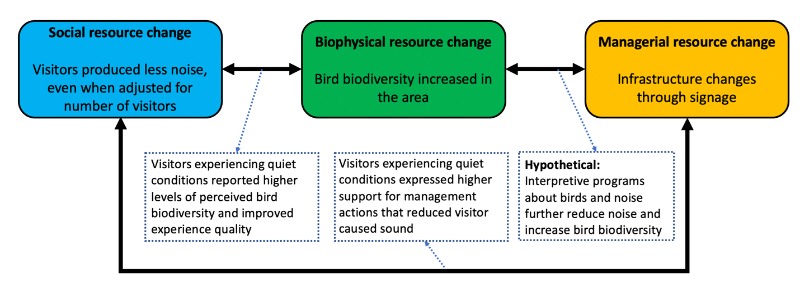
Figure 2 – An example of how visitor use affects social, biophysical, and managerial resources, and can also be affected by social, biophysical, and managerial resources.
However, visitor use may also be affected by changes in each of these resource types. Visiting Figure 2 again, dashed lines and boxes describe this reciprocity. When there was a shift in biophysical resources through increased bird biodiversity, visitors reported higher levels of perceived biodiversity and improved experience quality (Levenhagen et al. 2021). Additionally, when visitors experienced quieter conditions, they supported more diverse forms of management to keep the area quiet. Although not examined in the study, an additional hypothetical link is an interpretive program focusing on birds and noise from visitors, which may lead to an additional increase in noise reduction. Collectively, this demonstrates the complex, reciprocal, and interdisciplinary nature of visitor use management.
Visitor use management involves descriptive and evaluative relationships between visitor use and resource changes
Any amount of visitor use will create resource changes (Cole 2019). For instance, a single visitor will increase the number of people, the amount of sound, vegetation trampling, soil compaction, and vehicle volume in an area. All of these resource changes are descriptive in nature; they simply describe relationships between visitor use and resources. These descriptive aspects of visitor use are critical to understand, particularly for unpacking system complexity and describing current conditions (IVUMC 2016; McCool et al. 2014). However, these descriptive aspects alone are seldom sufficient to make decisions about visitor use management. This is because they are devoid of associated contextual meaning (Wagar 1964). These descriptive relationships must also include an evaluative component to understand whether these changes are good or bad, or acceptable or unacceptable (Figure 3).
The relationship between descriptive and evaluative components of resources is referred to as a threshold in visitor use management (IVUMF 2016). Critically, the evaluation of descriptive aspects of resource changes are dependent on the desired conditions of a setting. Thus, the same descriptive aspect, such as number of people, may be evaluated as positive or acceptable in one setting and negative or unacceptable in another.
An analogy for this context dependent descriptive-evaluative relation is the application of the concept to body temperature among different animal species. As demonstrated in Figure 4, depending on the context, a descriptive temperature of 98.6o F is evaluated differently. For a high-metabolism hummingbird, this may be too cold, indicating illness. For a human, this body temperate is just right. For an ectothermic lizard, this may be too hot. The same concepts can be applied to visitor use management. A dozen encounters with other visitors may be too crowded for a multi-day wilderness trip, just right for a day hike, and too sparse for a jog in the local park. The context dependent nature of the descriptive-evaluative dimension of visitor use management is critical in the interdisciplinary field. When decisions are made simply on descriptive aspects without this context-based evaluative consideration, challenges often arise (Bacon, Roche, Elliot, & Nicholas 2006). For instance, evaluating if a management action was successful can be difficult to determine without evaluative thresholds.
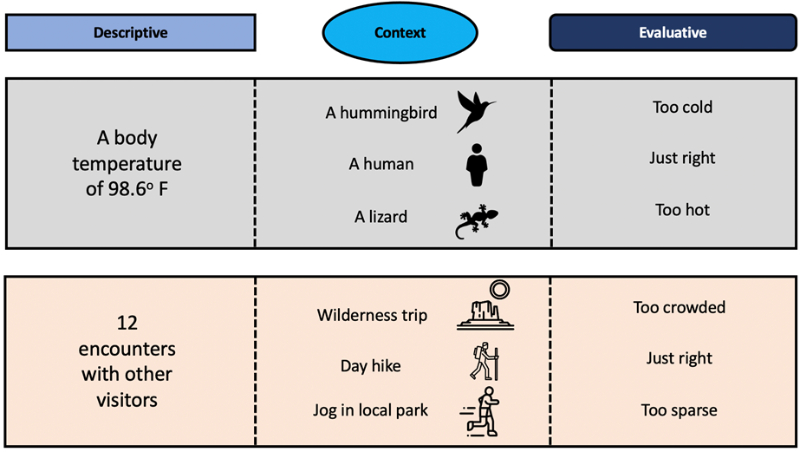
Figure 4 – Like body temperature and species, the relationship between descriptive and evaluative components of visitor use management is context dependent. Icon credit: Freepik
Visitor use management can occur at all temporal and spatial scales
Early studies identified multiphasic components to visitor experiences (Clawson & Knetsch 1966). These temporal phases include: 1) anticipation, 2) travel to site, 3) onsite participation, 4) travel from site, and 5) recollection (Clawson & Knetsch 1966; Figure 5). Anticipation is the earliest component of the visitor experience, where people often plan, make reservations, and generally set expectations and look forward to their experience. Traveling to a site can vary greatly from type of experience (i.e., a jog at the local park is much different than an international trip) but is comparatively short in duration. Onsite participation in some type of an experience is arguably the largest focus of research into and management of visitor use. Traveling from the site is similar in duration to traveling to a site. Lastly, recollection is generally the longest component of the visitor experiences. It is where people reflect, share, and possibly make decisions about re-engagement in an experience, thus starting the cycle over again at anticipation.
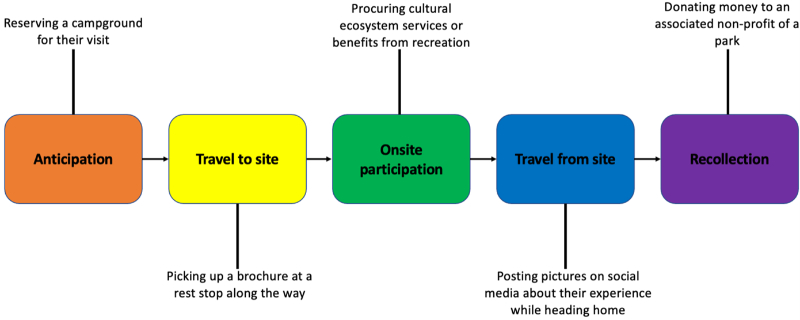
Figure 5 – Examples of visitor use across varying temporal components of the visitor experience (Clawson & Knetsch, 1966)
Although useful for thinking about the points and kind of visitor use management that can occur throughout the visitor experience, the framework described in Figure 5 masks additional nuances (Stewart 1998). For instance, the onsite participation component of visitor experience is much more dynamic and emergent than described. Even during onsite participation, the visitor experience evolves and changes (Borrie & Roggenbuck 2001). Nonetheless, this previous work shows how visitor use management can occur at different temporal scales. As an example, social media is used to help engage visitors during both the anticipation (Wilkins et al. 2018) and recollection phase (Miller & Freimund 2017). During the anticipation phase, visitors could use social media to plan aspects of their trip. In the recollection phase, visitors can engage a park via social media for a continuing relationship. Additionally, visitor experiences onsite help people procure recreational ecosystem services and benefits (Rice et al. 2020). As demonstrated in these examples, visitor use management can occur at different temporal points of the recreation experience.
Visitor use management also operates across multiple spatial scales. For instance, Manning et al. (1995) provided research to inform the management of visitor crowding at a single site. Scaling up, visitor experiences related to soundscapes in Denali National Park were studied across numerous locations to provide information for frontcountry planning (Miller, Taff, and Newman 2018). Zhang et al. (2021) examined levels of visitor use across the state of Utah to describe use levels at a landscape scale, and Pergams and Zaradic (2008) looked at per capita national park visitation across the entire country of the United States to understand long-term, nationwide shifts in visitor use. These examples demonstrate how visitor use can be managed at numerous spatial scales. Lastly, some visitor use management professionals are starting to integrate both the spatial and temporal aspects into conceptual models and management applications (Newton et al. 2017; Perry et al. 2020). As a single example, Nettles et al. (2021) examined longitudinal aspects of norms in a single spatial context.
Although these functional postulates demonstrate essential principles of visitor use management, they do not identify the core values which drive visitor use management. To understand these core values, normative postulates are described below.
Normative postulates
Visitor use management holds four normative postulates that act as core values for the field:
- visitor use management should maximize benefits to people while minimizing negative biophysical impacts
- research and science should be useful to managers and other professionals in decision-making about visitor use
- a range of different opportunities for visitors is a good thing
- a diversity of visitors is a good thing
Visitor use management should minimize negative biophysical impacts while maximizing benefits to people
As detailed earlier, most parks and protected areas have a dual mandate to protect resources and provide visitor experiences (Organic Act of 1916). Although this is often described as two competing objectives, this dual-mandate may be more accurately thought of as a reinforcing loop where the types and amount of use appropriate for an area are the same types and amounts of use that leave resources unimpaired (Miller et al. 2019). This is explicitly stated in frameworks that guide visitor use management among federal agencies in the United States: “Visitor use management is essential for maximizing benefits for visitors while achieving and maintaining desired resource conditions…” (IVUMC 2016, p. vii). Minimizing impacts to biophysical resources is also specified in case law related to visitor use management (Greater Yellowstone Coalition v. Kempthorne, 2008; Southern Utah Wilderness Alliance v. Dabney, 2000). Collectively, federal laws, agency guidance, and court rulings all demonstrate this core value.
“As we move further into an era of rapid change and uncertainty, the axioms of visitor use management can guide us towards a future that enriches the lives of a wide spectrum of the public while preserving our cherished resources for generations to come.”
Research and science should be useful to managers and other professionals in decision-making about visitor use
Visitor use management is an applied field of study in that its purpose is to improve or maintain desired conditions related to social, biophysical, and managerial resources in parks and protected areas. Without a sound connection to a management application, visitor use management research lacks relevance and meaning. In fact, this applied aspect of visitor use management research largely defines the field, and seldom will one find a research article related to visitor use management without a “management implications” section. Researchers and scientists in the visitor use management field often pull from numerous disciplines, including social psychology, sociology, economics, ecology, and anthropology. What distinguishes visitor use management from the fields it draws from is this shared commitment to applying the findings from research to improve decision making about managing visitor experiences and resource impacts in parks and protected areas.
A range of opportunities for visitors is good
In general conservation science, “biodiversity is good” is a driving normative postulate (Karieva & Marvier, 2012). Similarly, diversity in visitor opportunities is a good thing. This is perhaps best articulated as the Recreation Opportunity Spectrum (ROS; Stankey 1977; Driver et al. 1987). However, providing a diversity of recreation opportunities was proposed early on by Arthur Carhart and Aldo Leopold in the 1920s (Driver et al. 1987). This ROS approach allows visitors to choose the experience that best suits their needs, expectations, and goals, which facilitates achievement of benefits associated with their experience (Rice et al. 2020). This range of opportunities approach is often formally represented in zoning guidelines and associated desired conditions implemented by agencies (IVUMC 2016; Manning 2011). By providing a range of opportunities, managers create an inclusive system that serves a diversity of visitors.
A diversity of visitors is good
Although many park and protected areas are challenged with immediate issues related to high levels of visitation, per capita visitation to places like national parks has decreased for decades (Peregams & Zaradic 2008). Even during the recent rapid increase in visitation across the National Park Service, only 4% more people nationwide reported visiting a national park between 2009 and 2019 (RSG & WYSAC 2019). Additionally, visitors to places like our national parks are disproportionally White and non-Hispanic, and historically underrepresented races and ethnicities report more constraints and barriers in access to parks and protected areas (RSG & WYSAC, 2019). In fact, many non-White racial and ethnic groups report national parks to be unpleasant places at much higher rates than White racial groups (RSG & WYSAC, 2019). Even during the explosion of new outdoor recreationists during the COVID-19 pandemic, first time participants in outdoor recreation were more likely to be White than any other participant group (Taff et al. 2021). Additionally, people who previously participated in outdoor recreation but no longer do were significant more ethnically diverse (Taff et al. 2021). Collectively, this data shows that although visitor use to parks and protected area is increasing, participation in outdoor recreation by a more diverse segment of the US population is not.
With a diversifying American public that is less engaged with park and protected areas, general decreasing per capita visitation, and a disconnect from nature and associated waning public relevancy, the ability for agencies to fulfill their missions becomes a “wicked problem” (Machlis & McNutt 2011). Recognizing these long-term challenges, the NPS launched several initiatives to create a vision of a more inclusive future (NPS 2015). This includes a vision where the NPS, “…will fully represent our nation’s ethnically and culturally diverse communities” (NPS 2015, p. 5). Additionally, increasing visitor use to parks and protected areas among a broader swath of society could provide more ecosystem services and human well-being benefits provided by places like our national parks (Rice et al., 2020).
Conclusion
Inquiry into visitor use management has existed for over 50 years. As time progressed, our understanding of the issues and research questions became more complex. Today, Visitor Use Management stands as not only a framework, but a field of inquiry that is underpinned and guided by functional and normative postulates that organically emerged from the 50 years of history.
In the past decade, many US park and protected areas have been challenged with providing high quality visitor experiences while protecting resources in the face of record-breaking visitation year after year. In this time, not only has the process of visitor use management progressed through agency investments like the Interagency Visitor Use Management Council (IVUMC), but the interdisciplinary field of study called visitor use management has also progressed. Numerous graduate and undergraduate programs, hundreds if not thousands of peer reviewed papers, and many dedicated people have helped advance the science of visitor use management. As we move further into an era of rapid change and uncertainty, the axioms of Visitor Use Management can guide us towards a future that enriches the lives of a wide spectrum of the public while preserving our cherished resources for generations to come.
Acknowledgments
I am grateful to the numerous colleagues in academia, agencies, and non-profits that continuously helped me grow and progress my own understanding. In particular, thank you to the many graduate students I have worked with over the years who have always challenged my assumptions and expanded my horizons.
The views expressed in this paper are the responsibility of the authors and do not necessarily represent the opinions or policy of the National Park Service.
About the Author
ZACH MILLER is the visitor use analyst for the Intermountain Region of the National Park Service; email: zach_miller@nps.gov.
References
Allen, S. 2019. The Relationship Between Amount of Visitor Use and Social Impacts. Contributed paper. Prepared for the Interagency Visitor Use Management Council.
Bacon, J., J. Roche, C. Elliot, & N. Nicholas, N. 2006. VERP: Putting Principles into Practice in Yosemite National Park. George Wright Forum 23(2): 73–83.
Bennett, N. J., R. Roth, S. C. Klain, K. Chan, P. Christie, D. A. Clark, G. Cullman, D. Curran, T.J. Durbin, G. Epstein, A. Greenberg, M. P. Nelson, J. Sandlos, R. Stedman, T. L. Teel, R. Thomas, R., D. Veríssimo, & C. Wyborn. 2017. Conservation social science: Understanding and integrating human dimensions to improve conservation. Biological Conservation 205: 93–108. https://doi.org/10.1016/j.biocon.2016.10.006
Borrie, W. T. & J. W. Roggenbuck. 1998. Describing the wilderness experience at Juniper Prairie Wilderness using experience sampling methods. Wilderness & natural areas in eastern North America: research, management and planning. Nacogdoches, TX: Stephen F. Austin State University, Arthur Temple College of Forestry, Center for Applied Studies, pp. 165–72.
Borrie, W. T., & J. W. Roggenbuck. 2001. The dynamic, emergent , and multi-phasic nature of on-site wilderness experiences. Journal of Leisure Research 33(2): 202-228.Clawson, M., & J. Knetsch. 1966. Economics of outdoor recreation. Baltimore, MD: Johns Hopkins University Press.
Cole, D .N. 2019. The Relationship Between Amount of Visitor use and Environmental Impacts. Contributed paper. Prepared for the Interagency Visitor Use Management Council.
Driver, B. L., P. J. Brown, G. H. Stankey, & T. J. Gregoire. 1987. The ROS planning system: evolution, basic concepts and research needed. Leisure Sciences 9: 201–12.
Graefe, A. R., F. R. Kuss, & J. J. Vaske. 1990. Visitor Impact Management: The Planning Framework, vol. II. Washington, DC: National Parks and Conservation Association.
Greater Yellowstone Coalition v. Kempthorne, 577 F.Supp.2d 183, (2008).
Hof, M. & D. W. Lime. 1997. Visitor experience and resource protection framework in the national park system: rationale, current status, and future direction. In Stephen F. McCool and David N. Cole, compilers, Proceedings – Limits of Acceptable Change and Related Planning Process: Progress and Future Directions, pp. 26–9. Ogden, UT: US Department of Agriculture, Forest Service, Rocky Mountain Research Station.
IVUMF [Interagency Visitor Use Management Framework] 2016. The Interagency Visitor Use Management Council. Available at http://visitorusemanagement.nps.gov.
Karieva, P., & M. Marvier. 2012. What Is Conservation Science? BioScience 62(11): 962–969. https://doi.org/10.1525/bio.2012.62.11.5
Levenhagen, M. J., Z. D. Miller, A. R. Petrelli, L. A. Ferguson, Y. J. Shr, D. G. E. Gomes, B. D. Taff, C.White, K. Fristrup, C. Monz, C. J. W. Mcclure P. Newman, C. D. Francis, & J. R. Barber. 2021. Ecosystem services enhanced through soundscape management link people and wildlife. People and Nature, May, 1–14. https://doi.org/10.1002/pan3.10156
Machlis, G. E., & M. K. McNutt. 2011. Black swans, wicked problems, and science during crises. Oceanography 24(3): 318–320.
Manning, R. B. 2011. Studies in Outdoor Recreation: Search and Research for Satisfaction (3rd ed.). Corvallis, OR: Oregon State University Press.
Mccool, S. F., R. N. Clark, & G. H. Stankey. 2007. An Assessment of Frameworks Useful for Public Land Recreation Planning. Seattle, WA: United States Department of Agriculture Forest Service Pacific Northwest Research Station.
Mccool, S. F., W. A. Freimund, & C. Breen. 2014. Benefiting from Complexity Thinking. In G. L. Worboys, Lockwood, A. Kothari, S. Feary, & I. Pulsford (Eds.), Protected Area Governance and Management (1st ed., pp. 3–35). ANU Press.
McCool, S. F., & D. W. Lime. 2001. Tourism carrying capacity: Tempting fantasy or useful Reality? Journal of Sustainable Tourism 9(5): 372–388. https://doi.org/10.1080/09669580108667409
Miller, Z. D., & W. Freimund. 2017. Virtual visitors: Facebook users and national parks. Journal of Park and Recreation Administration 35(3): 136–150.
Miller, Z. D., W. Freimund, S. A.Crabtree, & E. P. Ryan. 2021. No limits of acceptable change: A proposed research framework for informing visitor use management in the context of cultural resources. Sustainability, 13.
Miller, Z. D., W. L. Rice, B. D. Taff, & P. Newman. 2019. Concepts for understanding the visitor experience in sustainable tourism. In S. F. Mccool & K. Bosak (Eds.), A Research Agenda for Sustainable Tourism (pp. 53–69). https://doi.org/10.4337/9781788117104.00012
Miller, Z. D., B. D. Taff, & P. Newman. 2018. Visitor Experiences of Wilderness Soundscapes in Denali National Park and Preserve. International Journal of Wilderness 24(2): 32–43.
Nettles, J. M., M. T. J. Brownlee, R. Sharp, M. P. Blacketer, and J. C. Hallo. 2021. Norm stability: Visitors’ perceptions of crowding at Cumberland Island National Seashore. Leisure Sciences DOI: 10.1080/01490400.2020.1855275
Newton, J. N., P. Newman, B. D. Taff, A. D’Antonio, & C. Monz. 2017. Spatial temporal dynamics of vehicle stopping behavior along a rustic park road. Applied Geography 88: 94-103.NPS. 2015. A Call to Action. Retrieved from https://www.nps.gov/calltoaction/PDF/C2A_2015.pdf
Organic Act of 1916. 16 U.S.C. §§ 1–4.
Pergams, O. R. W., & P. A. Zaradic. 2008. Evidence for a fundamental and pervasive shift away from nature-based recreation. Proceedings of the National Academy of Sciences, 105(7).
Perry, E. E., J. M. Thomsen, A. L. D’Antonio, W. C. Morse, N. P. Reigner, Y. F. Leung, J. Wimpey, & B. D. Taff. 2020. Toward an integrated model of topical, spatial, and temporal scales of research inquiry in park visitor use management. Sustainability 12(15): 1–21. https://doi.org/10.3390/su12156183
Resource Systems Group (RSG) and Wyoming Survey and Analysis Center (WYSAC). (2019). National Park Service comprehensive survey of the American public: 2018 – racial and ethnic diversity of National Park System visitors and non-visitors. Natural Resource Report. NPS/NRSS/EQD/NRR—2019/2042. National Park Service. Fort Collins, CO. Retrieved from https://irma.nps.gov/DataStore/Reference/Profile/2267482
Rice, W. L., B. D. Taff, Z. D. Miller, P. Newman, K. Y. Zipp, B. Pan, J. N. Newton, & A. D. Antonio. 2020. Connecting motivations to outcomes: A study of park visitors’ outcome attainment. Journal of Outdoor Recreation and Tourism 29. https://doi.org/10.1016/j.jort.2019.100272
Santucci, V. L., P. Newman, & B. D. Taff. 2016. Towards a conceptual framework for assessing the human dimensions of paleontological resources. New Mexico Museum of Natural History and Science Bulletin, 74: 239–248.
Soulé, M.E. 1985. What is conservation biology? BioScience, 35: 727-734.Southern Utah Wilderness Alliance v. Dabney, 222 F.3d 819, (2000).
Stankey, G. H. 1977. Some social concepts for outdoor recreation planning. In Outdoor Recreation: Advances in Application of Economics, pp. 154–61. General Technical Report WO-2. Washington, DC: United States Department of Agriculture Forest Service.
Stankey, G. H, D. N. Cole, R. Lucas, M. E. Peterson, & S. S. Frissell. 1985. The Limits of Acceptable Change (LAC) System for Wilderness Planning. Ogden, UT: US Department of Agriculture, ForestService, Intermountain Forest and Range Experiment Station.
Stankey, G. H., S. F. McCool, & G. L. Stokes. 1984. Limits of acceptable change: A new framework for managing the Bob Marshall Wilderness Complex. Western Wildlands 10(3): 33–7.
Stewart, W. P. 1998. Leisure as multiphase experiences: Challenging traditions. Journal of Leisure Research 30(4): 391.
Sumner, E. L. 1936. Special Report on a Wildlife Study in the High Sierra in Sequoia and Yosemite National Parks and Adjacent Territory. Washington, DC: US National Park Service Records, National Archives
Taff, B. D., W. L. Rice, B. Lawhon, & P. Newman. 2021. Who Started, Stopped, and Continued Participating in Outdoor Recreation during the COVID-19 Pandemic in the United States? Results from a National Panel Study. Land 10(12): 1396. https://doi.org/10.3390/land10121396
Wagar, J. A. 1964. The Carrying Capacity of Wild Lands for Recreation. Washington, DC: Society of American Foresters.
Whittaker, D., B. Shelby, R. E. Manning, D. Cole, & G. Haas. 2011. Capacity Reconsidered: Finding consensus and clarifying differences. Journal of Park and Recreation Administration 29(1): 1–20.
Wilkins, E. J., J. W. Smith, & R. Keane. 2018. Social media communication preferences of national park visitors. Applied Environmental Education & Communication 19(1): 4–18. https://doi.org/10.1080/1533015X.2018.1486247
Yellowstone Park Act of 1872. 16 U.S.C. §§ 21.
Yosemite Grant Act of 1864. 16 U.S.C. §§ 48.
Zhang, H., D. Berkel, P. D. Van Howe, Z. D. Miller, & J. W. Smith. 2021. Using social media to measure and map visitation to public lands in Utah. Applied Geography June: 102389. https://doi.org/10.1016/j.apgeog.2021.102389
Read Next
Are We in Need of “Triage” for Wilderness?
As part of a larger management strategy, “triage” actions can work with long term decision-making to provide wilderness managers with the best practices necessary for wilderness stewardship.
Nature in the Anthropocene: What it no longer is, Will never again be, and What it can become
Nature changes in response to changing conditions, and so must our conception of it.
Biodiversity: The Language of Wilderness
“Biodiversity: The language of wilderness” is part of Northeast Wilderness Trust’s “Wild Works” series, which characterizes the values and benefits of wild, unmanaged landscapes.

